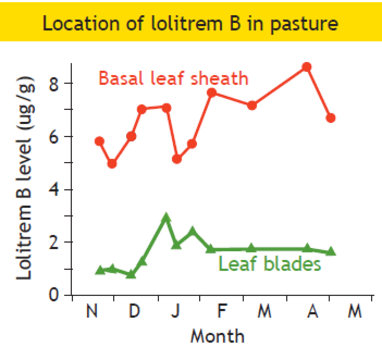Endophyte Alkaloids
Ryegrass endophytes produce different alkaloids:

Peramine
Peramine is an alkaloid produced by some ryegrass endophytes. It provides good control of the pasture pests Argentine stem weevil and pasture mealy bug. It is not believed to have any adverse effect on animals.
Lolitrem B and ryegrass staggers

Lolitrem B is the alkaloid produced by some ryegrass endophytes. At high levels it can cause ryegrass staggers or summer staggers in animals.
Animals grazing ryegrass with Standard endophyte (SE) are most likely to suffer staggers. Little seed with SE is sown nowadays, it is mainly found in old pastures. The worst staggers occurs when animals are pushed to graze into the base of plants in dry summers, or grazing the first pick of green growth following a dry spell. This is because lolitrem B is concentrated in the base of the plant (see graph).
Lolitrem B is also found in seed heads, so grazing rank seedy pasture can also cause problems.
Staggers present as tremoring in mild cases and staggering in more severe cases. Animals rarely die directly from staggers, but may die through misadventure, such as drowning in streams.
Staggers causes severe management problems if stock must be regularly handled, e.g. milking cows. A low level of staggers usually clears up within 1-2 days if animals are fed a diet free from lolitrem B. Severe staggers can affect animals for weeks.
NEA, NEA2 and NEA4 endophytes produce very low levels of lolitrem B, so provide staggers free pasture for dairy cows and beef cattle. On sheep or deer farms, while ryegrass staggers is unlikely to occur, in dry summers if animals are forced to graze close to the ground a low level of staggers may be seen.
Lolitrem B is very stable in hay or silage so be careful buying or feeding these if they are made from Standard endophyte pasture.
Ergovaline
Ergovaline helps protect plants against insects, including black beetle and root aphid, but high levels of ergovaline (e.g. from Standard endophyte) can sometimes reduce animal performance. NEA, NEA2 and NEA4 endophytes produce low to moderate levels of ergovaline which tests have shown are unlikely to affect animal health and performance under good grazing management.
The distribution of ergovaline through the plant differs for different endophytes. For NEA, NEA2 and NEA4, ergovaline levels are very low in ryegrass leaves, but are moderate in the plant crown. This is an important benefit as leaves are your animals’ main diet, whereas the crown of the plant, containing the growing point, needs protection from insect damage.
Animal health trials on NEA2 endophyte in diploid ryegrass have shown the same lamb growth as those on the same ryegrass Without endophyte.
Lamb liveweight gain (LWG) in Lincoln University trials

Trials suggest the ergovaline intake of dairy cows grazing well managed NEA2-based ryegrass pastures is unlikely to affect animal production. A review of animal intake research* showed that ergovaline intakes below 0.03 mg/kg LW0.75/day have never shown any effect on animal performance, with diploid NEA2 pastures testing at this safe level (see graph).

Calculated ergovaline intakes of cows grazing Standard endophyte were almost double NEA2, at which level ergovaline effects could possibly be seen.
The concentration of ergovaline in ryegrass is highest in the plant crown and seed head. Ergovaline increases in summer with rising temperature and seed head development, and in response to moisture stress. To minimise animal health issues keep pastures leafy through late spring, and try not to graze close to the ground in summer. Use other feeds (e.g. summer crops, silage, PKE, grain) to dilute alkaloid intake and greatly reduce the risk of any endophyte issues.
Janthitrem
Janthitrems are alkaloids produced by NEA12, AR37, CM142 and RGT18 endophytes.
They produce no peramine, lolitrem B or ergovaline.
Janthitrem levels follow the seasonal pattern of other alkaloids, i.e. low in winter and high in late summer and autumn, and give a wide spectrum of insect resistance.
High levels of janthitrems can cause staggers, although this is not as severe as that caused by Standard endophyte. In lamb LWG trials, ryegrasses
with NEA12 and AR37 pastures can cause ryegrass staggers in sheep typically in dry summers where animals are pushed to eat into the base of pasture. This can be severe, and will impact animal health and growth.
Similar to lolitrem B, a low level of staggers usually clears up within 1-2 days if animals are fed a diet free from janthitrems. Severe staggers can affect animals for weeks. In endophyte trials run by DairyNZ no ryegrass staggers have been seen in dairy cows grazing AR37. Although on occasion AR37 has been shown to effect milksolids (MS) production, over the whole season MS production has been shown to be similar for AR37 and AR1.
Lolines
Lolines are alkaloids produced by meadow fescue endophyte (Neotyphodium uncinatum), and give a wide spectrum of insect resistance. They are produced at good levels in meadow fescue plants, but when these endophytes have been put into perennial ryegrass cultivars loline levels are typically much lower.
They are also translocated to the roots of the plant so can assist in deterring root feeding insects.
While meadow fescues with loline producing endophytes have good insect control, they are typically slow to establish, low yielding, and have limited cool season growth.


